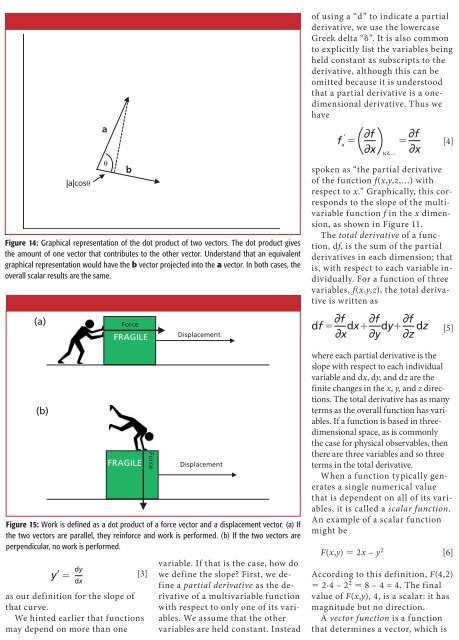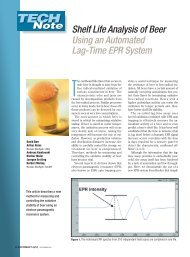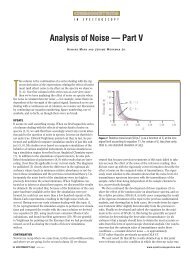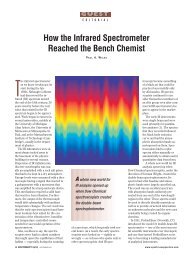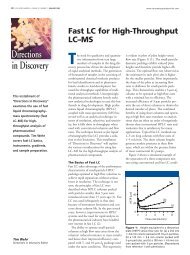Experimental - Spectroscopy
Experimental - Spectroscopy
Experimental - Spectroscopy
You also want an ePaper? Increase the reach of your titles
YUMPU automatically turns print PDFs into web optimized ePapers that Google loves.
20 <strong>Spectroscopy</strong> 26(6) June 2011<br />
www.spectroscopyonline.com<br />
|a|cosθ<br />
[3]<br />
as our definition for the slope of<br />
that curve.<br />
We hinted earlier that functions<br />
may depend on more than one<br />
a<br />
θ<br />
b<br />
Figure 14: Graphical representation of the dot product of two vectors. The dot product gives<br />
the amount of one vector that contributes to the other vector. Understand that an equivalent<br />
graphical representation would have the b vector projected into the a vector. In both cases, the<br />
overall scalar results are the same.<br />
(a)<br />
(b)<br />
Force<br />
FRAGILE<br />
FRAGILE<br />
Force<br />
Displacement<br />
Displacement<br />
Figure 15: Work is defined as a dot product of a force vector and a displacement vector. (a) If<br />
the two vectors are parallel, they reinforce and work is performed. (b) If the two vectors are<br />
perpendicular, no work is performed.<br />
y = dy<br />
dx<br />
variable. If that is the case, how do<br />
we define the slope? First, we define<br />
a partial derivative as the derivative<br />
of a multivariable function<br />
with respect to only one of its variables.<br />
We assume that the other<br />
variables are held constant. Instead<br />
of using a “d” to indicate a partial<br />
derivative, we use the lowercase<br />
Greek delta “δ”. It is also common<br />
to explicitly list the variables being<br />
held constant as subscripts to the<br />
derivative, although this can be<br />
omitted because it is understood<br />
that a partial derivative is a onedimensional<br />
derivative. Thus we<br />
have<br />
∂f ∂f<br />
= =<br />
∂x ∂x<br />
'<br />
f<br />
x ()<br />
y,z,...<br />
[4]<br />
spoken as “the partial derivative<br />
of the function f(x,y,z,…) with<br />
respect to x.” Graphically, this corresponds<br />
to the slope of the multivariable<br />
function f in the x dimension,<br />
as shown in Figure 11.<br />
The total derivative of a function,<br />
df, is the sum of the partial<br />
derivatives in each dimension; that<br />
is, with respect to each variable individually.<br />
For a function of three<br />
variables, f(x,y,z), the total derivative<br />
is written as<br />
∂f ∂f ∂f<br />
df = dx+ dy+<br />
dz<br />
∂x ∂y ∂z<br />
[5]<br />
where each partial derivative is the<br />
slope with respect to each individual<br />
variable and dx, dy, and dz are the<br />
finite changes in the x, y, and z directions.<br />
The total derivative has as many<br />
terms as the overall function has variables.<br />
If a function is based in threedimensional<br />
space, as is commonly<br />
the case for physical observables, then<br />
there are three variables and so three<br />
terms in the total derivative.<br />
When a function typically generates<br />
a single numerical value<br />
that is dependent on all of its variables,<br />
it is called a scalar function.<br />
An example of a scalar function<br />
might be<br />
F(x,y) = 2x – y 2 [6]<br />
According to this definition, F(4,2)<br />
= 2∙4 – 2 2 = 8 – 4 = 4. The final<br />
value of F(x,y), 4, is a scalar: it has<br />
magnitude but no direction.<br />
A vector function is a function<br />
that determines a vector, which is


